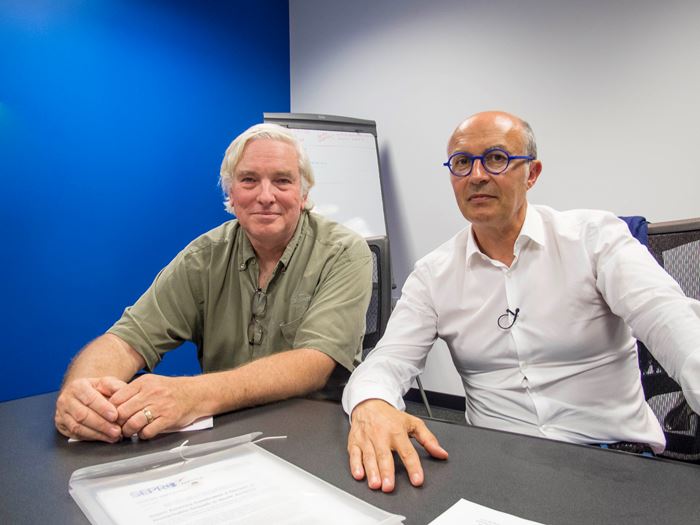Sepro America Expands To Assemble Big Robots
Sepro America celebrated its 10th anniversary last week. showing off new space that will more than double its manufacturing area in Warrendale, Pa., including room for its first U.S. assembly of large robots.
Sepro America, a branch of the France’s largest robot maker, celebrated its 10th anniversary last week and showed off newly acquired space that will more than double its manufacturing area in Warrendale, Pa. The current facility occupies 16,500 ft2, 9000 ft2 of that for assembly of sprue pickers and custom cell automation.
A contiguous space, recently vacated by another tenant, will give Sepro America another 11,000 ft2, to be used for its first U.S. assembly of large robots—those intended for presses of more than 700 tons clamp force (such as the 7X model pictured). Sepro intends to begin this new activity by January 2018. Jean-Michel Renaudeau, managing director of Sepro Group in France, said his target is to assemble 30 large robots next year and 100 in 2019, or about half of the large units expected to be sold in the U.S. that year. The new assembly project will be directed by Loic Legendre, v.p. service.
Sepro’s U.S. presence dates back to 1989, when it formed a sales and distribution relationship with Conair, Cranberry Township, Pa. In the next 18 years, Sepro’s U.S. sales rose to as many as 250 robots per year, ranking first in market share in the auto industry and in robots for injection presses over 700 tons. In order to develop an even stronger position, Renaudeau decided in 2007 to form a separate 50/50 joint venture with Conair, staffed with all of Conair’s automation sales, engineering, and service employees, including Jim Healy, who became v.p. sales and marketing of the new Sepro America, and Bill Geddis, v.p. sales and automation.
Renaudeau concedes that it was a risky move to sever what had been such a successful relationship with Conair, one of the biggest names in auxiliary equipment—and, as it turned out, when a deep recession was just around the corner. But just 15 months later, buoyed by strong sales, Renaudeau bought out the other half of the j.v. to make Sepro America a wholly owned daughter company. Clearly, the gamble paid off. In its first full year, Sepro America sold 149 robots, a number that grew to 541 units last year. As a free-standing company, Sepro America’s market share grew from 9% to 25% in 2016, Renaudeau said. His target is a 30% share, or 650-700 units sold in the U.S., out of around 800 total for North America—a number he aims to grow to 1000 units total.
Renaudeau’s plans include assembling large robots for Canada and Mexico in Warrendale, instead of shipping the bulky units directly from France, as is the case today.
Today, there are some 6000 Sepro robots installed in North America, out of around 30,000 globally. Sepro America is now complemented by Sepro Canada and Sepro Mexico. Renaudeau’s plans include assembling large robots for Canada and Mexico in Warrendale, instead of shipping the bulky units directly from France, as is the case today. Globally, Sepro has private-label and other OEM arrangements with injection press suppliers such as Sumitomo (SHI) Demag, Billion, Stork, and Milacron Europe. Renaudeau is seeking further OEM agreements, which can include whole or partial integration of the robot controls with the injection press controller.
In attendance at the 10th anniversary celebration last week was David Alan Bourne, principal scientist-robotics and director of the Rapid Manufacturing Lab at Carnegie Mellon University’s Robotics Institute in nearby Pittsburgh. Bourne, who calls himself “the first robotics professor in America,” has been at Carnegie Mellon for 37 years and for the last two years has been working with Sepro on software development. He said Sepro was interested in modernizing the robot controls and programming language. But after consulting with Sepro customers, it was decided that new technology to minimize machine downtime was a priority. Thus Bourne and his team were re-tasked to consider “smart” predictive maintenance using machine learning. The goal is to sense factors such as vibration and power draw to detect problems developing with servo motors or beam distortion and alert the user before an actual failure occurs.
Related Content
How Was K 2022 for Blow Molding?
Over a dozen companies emphasized sustainability with use of foam and recycle, lightweighting and energy savings, along with new capabilities in controls, automation and quick changeovers.
Read MoreCobot Creates 'Cell Manufacturing Dream' for Thermoformer
Kal Plastics deploys Universal Robot trimming cobot for a fraction of the cost and lead time of a CNC machine, cuts trimming time nearly in half and reduces late shipments to under 1% — all while improving employee safety and growth opportunities.
Read MoreA Cost Saving Modular Approach to Resin Drying Automation
Whether implementing a moisture-sensing closed-loop system for a single dryer, or automating an entire plant, technology is available to take the guesswork and worry out of resin drying. Using a modular approach allows processors to start simple and build more capabilities over time.
Read MoreReal-Time Production Monitoring as Automation
As an injection molder, Windmill Plastics sought an economical production monitoring system that could help it keep tabs on its shop floor. It’s now selling the “very focused” digital supervisor it created, automating many formerly manual tasks.
Read MoreRead Next
Advanced Recycling: Beyond Pyrolysis
Consumer-product brand owners increasingly see advanced chemical recycling as a necessary complement to mechanical recycling if they are to meet ambitious goals for a circular economy in the next decade. Dozens of technology providers are developing new technologies to overcome the limitations of existing pyrolysis methods and to commercialize various alternative approaches to chemical recycling of plastics.
Read MoreProcessor Turns to AI to Help Keep Machines Humming
At captive processor McConkey, a new generation of artificial intelligence models, highlighted by ChatGPT, is helping it wade through the shortage of skilled labor and keep its production lines churning out good parts.
Read More



























